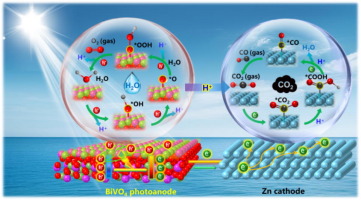Abstract
Herein, we demonstrated the integration of BiVO4-based photoanode with metallic Zn cathode for highperformance CO2 reduction, and a record CO production rate of 113.32 lmol cm-2 h-1 with a FECO of 90.57 % has been achieved under simulated sunlight (AM 1.5 G, 100 mW), accompanying with an excellent stability. More importantly, the direct observation of spatial charge separation/transfer and dynamic surface catalysis for both H2O oxidation and CO2 reduction has been firstly achieved by the combination of in situ X-ray photoelectron spectroscopy (IS-XPS) with Fourier transform infrared reflection (IS-FTIR). Under light irradiation, the electron-hole pairs have been generated on BiVO4 photoanode, and holes rapidly transfer to photoanode surfaces for participating in oxygen evolution reaction (OER) through the formation of *OH and *OOH intermediates. Simultaneously, the proton-coupled electron transfer to the Zn cathode surfaces drive the reduction of adsorbed CO2 molecules into CO via the formation *COOH and *CO intermediates. Thereby, this work offers new insights into fundamental understanding of CO2 reduction process, which facilitates the future development of highly efficient carbon fixation systems. (c) 2025 Science Press and Dalian Institute of Chemical Physics, Chinese Academy of Sciences. Published by Elsevier B.V. and Science Press. All rights are reserved, including those for text and data mining, AI training, and similar technologies.

Keywords Plus:REDUCTION,EFFICIENT,PHOTOANODE,OXIDATION,CONVERSION,H2O,HETEROJUNCTION,PHOTOCATALYSTS,FORMATE,SYSTEM
Published in JOURNAL OF ENERGY CHEMISTRY,Volume112;10.1016/j.jechem.2025.08.073,JAN 2026


